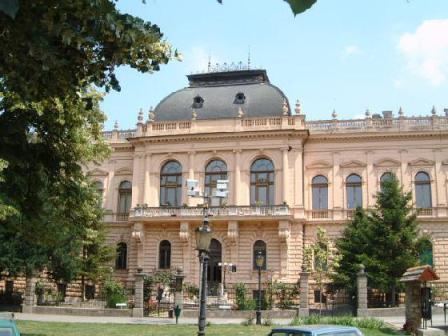
Scientific Rationale
The spectral lines, their widths, and shapes, are powerful tools for
emitting/absorbing gas diagnostics in different astrophysical objects
(from the Solar system to the most distant objects in the Universe -
quasars). The emission/absorption lines of astrophysical objects are
produced over a wide range of distances from an observer and under a
wide range of physical and kinematical conditions. Therefore in
astrophysical objects the lines from X-ray (Fe K) to the radio
(radio recombination line) have been observed. On the other hand,
the experimental and theoretical investigations of laboratory plasma
have been applied in spectroscopic astrophysical research, especially
atomic data needed for line shape calculations. This conference will
bring together astronomers (observers and theoreticians) and
physicists to review the present stage of investigation (Serbia
and elsewhere), with the aim of improving our knowledge in this
field, and to better understand the significance of emission/absorption
lines for future astrophysical investigations.
The program will focus on:
- Stellar and interstellar spectral lines
- Spectral line phenomena in extragalactic objects
- Spectral lines in laboratory plasma
Scientific Organizing Committe
Milan S. Dimitrijevic (Astronomical Observatory, Belgrade, Serbia)
- Co-chairman (mdimitrijevic@aob.bg.ac.yu)
Luka C. Popovic (Astronomical Observatory, Belgrade, Serbia)
- Co-chairman (lpopovic@aob.bg.ac.yu)
Edward Baron (University of Oklahoma, Norman, USA)
Nebil Ben Nessib (Institut National des Sciences Appliques et de Technologie, Tunis, Tunisia)
John Danziger (Osservatorio Astronomico di Trieste, Italy)
Emanuel Danezis (University of Athens, Greece)
Peter Hauschildt (Hamburger Sternwarte, Hamburg, Germany)
Darko Jevremovic (Astronomical Observatory, Belgrade, Serbia)
Evencio Mediavilla (Instituto de Astrofsica de Canarias, Spain)
Anatolij A. Mihajlov (Institute of Physics, Zemun, Serbia)
Vladimir Milosavljevic (Faculty of Physics, Belgrade, Serbia)
Gillian Peach (University College, London, United Kingdom)
Jagos Puric (Faculty of Physics, Belgrade, Serbia)
Tanya Ryabchikova (Institute of Astronomy, Russian Academy of Scieces, Russia)
Myakzyum Kh. Salakhov (Kazan State University, Russia)
Aleksandar F. Zakharov (Institute of Theoretical and Experimental Physics, Moscow, Russia)
Local Organizing Committee
Luka C. Popovic (Astronomical Observatory, Belgrade, Serbia)
- Chairman (lpopovic@aob.bg.ac.yu)
Dragana Ilic (Faculty of Mathematics, Belgrade)
- Co-vice chairperson (dilic@matf.bg.ac.yu)
Nenad Milovanovic (Astronomical Observatory, Belgrade)
- Co-vice chairperson (nmilovanovic@aob.bg.ac.yu)
Edi Bon (Astronomical Observatory, Belgrade)
Miodrag Dacic (Astronomical Observatory, Belgrade)
Milan S. Dimitrijevic (Astronomical Observatory, Belgrade)
Predrag Jovanovic (Astronomical Observatory, Belgrade)
Tanja Milovanov (Astronomical Observatory, Belgrade)
Zoran Simic (Astronomical Observatory, Belgrade)
Natasa Gavrilovic (Astronomical Observatory, Belgrade)
Tihomir Petrovic (Astronomical Observatory, Belgrade)
Jelena Kovacevic (Astronomical Observatory, Belgrade)
 Venue
Venue
The conference will be held in hotel "Dunav" in Sremski Karlovci.
Sremski Karlovci, "a town of history" is located on mild slopes spreading from the
Danube towards Fruska Gora, on the road connecting Novi Sad and Belgrade (12 km
from Novi Sad). The settlement in the outskirts of Fruska Gora valley, towards the
river, has existed here from ancient times.
Architectural monuments of Sremski Karlovci are rare examples of style and
artistic shaping.
The Orthodox Church built (1758-1762) in a baroque style, with the changed
renaissance facade (1909) treasures the exquisite works of painters such as
Kracun, Cesljar, Orfelin and Paja Jovanovic.
The building of the Magistrate (1806-1811) in the empire style represents a fine
example of such architecture.
The Roman-catholic church, built at the beginning of the 18th century and renewed
in 1768, possesses interesting elements in the complex of diverse construction.
History of Sremski Karlovci
The town was first mentioned in historical documents in 1308 with the name Karom.
Until 1521, the Karom was a possession of the Hungarian noble family Báthory.
Turkish military commander Bali-beg conquered Karom in 1521, and in the next 170
years, the town was part of the Ottoman Empire. The Slavic name for the town -
Karlovci, was first recorded in 1533.
Between November 16, 1698, and January 26, 1699, the town of Sremski Karlovci was
the site of a congress that ended the hostilities between the Ottoman Empire and
the Holy League, a coalition of various European powers including Austria, Poland,
Venice and Russia; the congress produced the Treaty of Karlowitz. After this peace
treaty, the town was part of the Habsburg Monarchy and was included into the
Military Frontier. According to the 1702 data, the population of the town was
composed of 215 Orthodox and 13 Catholic houses, while according to the 1753 data,
the population of the town numbered 3,843 people, of which 3,110 were ethnic
Serbs.
The town was also the spiritual, political and cultural center of the Serbs in the
Austrian empire. The Metropolitan of the Serb Orthodox Church resided in the town.
To this day, the Serb Orthodox Patriarch retains the title of Metropolitan of
(Sremski) Karlovci. The town also featured the earliest Serb (and Slavic in
general) grammar school (Serbian: gimnazija/гимназија, French: lycée) founded on August 3rd, 1791. Three years after this, an Orthodox seminary was also founded in
the town. It was the second oldest Orthodox seminary in the World (After the
Spiritual Academy in Kiev), and it operates to this day.
On the Serb National Assembly in Sremski Karlovci in May, 1848, Serbs declared the
unification of the regions of Srem, Banat, Bačka, and Baranja (including parts of
the Military Frontier) into the province of Serbian Vojvodina. The first capital
of Serbian Vojvodina was in Sremski Karlovci, until it was latter moved to Zemun,
Veliki Bečkerek, and Temišvar.
When Serbian Vojvodina was in 1849 transformed into the new province named
Vojvodina of Serbia and Tamiš Banat, Sremski Karlovci were not included into this
province, but were returned under the administration of the Military Frontier
(Slavonian Krajina). With the abolishment of the Military Frontier in 1881, the
town was included into Croatia-Slavonia, the autonomous kingdom within
Austria-Hungary.
In 1918, the town became part of the Kingdom of Serbs, Croats and Slovenes. In the
1920s, the town became the headquarters of Russian White émigrés of General
Wrangel whose monument remains to this day. It was also home to the Holy Synod of
the Russian Orthodox Church Outside Russia.
Between 1929 and 1941, the town was part of Danube Banovina, a province of the
Kingdom of Yugoslavia. During World War 2 (1941-1944), the town was occupied by
the Axis Powers and it was attached to the Independent State of Croatia. During
that time its name was changed to Hrvatski Karlovci. Since the end of the war, the
town has been part of the Autonomous Province of Vojvodina.
Between 1980 and 1989, Sremski Karlovci was one of the seven municipalities of
Novi Sad City. Today, the municipality is not part of Novi Sad City, but a
separate administrative unit.

 Venue
Venue 

